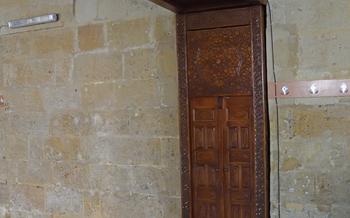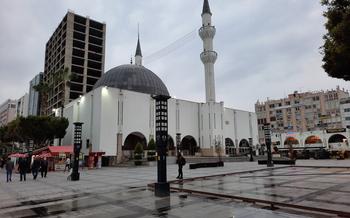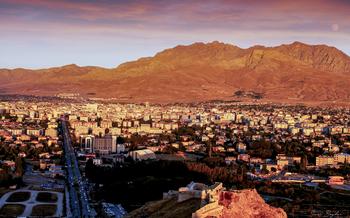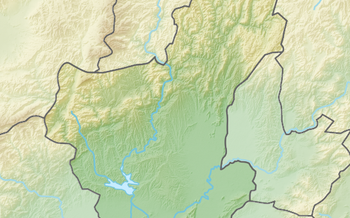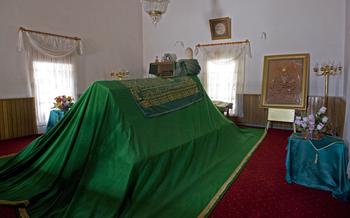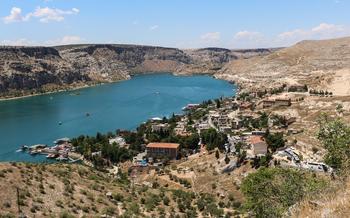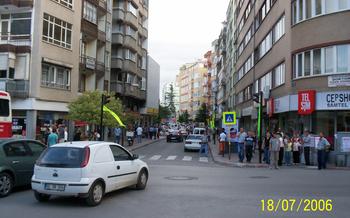
Boyaci Mosque
- Historical Significance:
- Architectural Marvel
- Prayer Hall Serenity
- Calligraphy and Inscriptions
- Courtyard Oasis
- Cultural Symbol:
- Local Customs and Etiquette
- Pilgrimage Destination
- Visitor Information
- Photography Tips
- Educational Programs
- Community Involvement
- Historical Context
- Insider Tip:
Historical Significance:
The Boyaci Mosque stands as a testament to the rich history and cultural heritage of Gaziantep. Its construction during the Ottoman Empire in the 16th century reflects the city's significance as a major center of trade and culture. The mosque's unique architectural style, which blends Islamic and Turkish elements, showcases the artistic and cultural influences that shaped the region during that era. As a symbol of religious devotion and community gathering, the Boyaci Mosque has played a vital role in the spiritual and social life of Gaziantep for centuries. It continues to attract worshippers, visitors, and pilgrims alike, offering a glimpse into the city's vibrant past and enduring traditions.
Architectural Marvel
The Boyaci Mosque stands as a testament to the exquisite artistry and architectural prowess of the Ottoman Empire. Its exterior is adorned with intricate tilework, showcasing vibrant colors and intricate patterns that create a mesmerizing visual tapestry. The stained-glass windows, with their kaleidoscopic hues, illuminate the interior, casting a warm and ethereal glow upon the prayer hall. The mosque's dome, a symbol of Islamic architecture, dominates the skyline, while the minarets, slender and graceful, seem to pierce the heavens, inviting the faithful to prayer. The harmonious blend of colors, patterns, and architectural elements creates a breathtaking spectacle that leaves visitors in awe.
Prayer Hall Serenity
Stepping inside the Boyaci Mosque, you'll be greeted by a profound sense of tranquility that envelops the prayer hall. The elegant mihrab (prayer niche) immediately catches your eye, its intricate carvings indicating the direction of Mecca. The harmonious blend of colors and patterns creates a mesmerizing visual effect, further enhancing the serene atmosphere.
As you observe the worshippers gathered for daily prayers, you'll notice a palpable spiritual energy that permeates the air. The melodious call to prayer (adhan) echoes through the hall, inviting the faithful to come together in devotion. The rhythmic movements and synchronized voices of the worshippers create a captivating spectacle that showcases the unity and harmony within the Muslim community.
Whether you're a devout Muslim or simply a curious traveler, the prayer hall of the Boyaci Mosque offers a unique opportunity to witness the depth of religious devotion and the strong sense of community that exists among the local people. It's a place where you can find solace, peace, and a deeper understanding of the Islamic faith.
Calligraphy and Inscriptions
Admire the exquisite calligraphy that adorns the Boyaci Mosque's walls and arches. Skilled calligraphers have meticulously inscribed verses from the Quran and religious teachings in elegant Arabic script. The intricate designs and harmonious flow of the letters create a mesmerizing visual effect, adding to the mosque's spiritual atmosphere.
Decipher the inscriptions to gain insights into Islamic teachings and the history of the mosque. These inscriptions often include the names of Allah, the Prophet Muhammad, and other significant figures from Islamic history. They serve as a reminder of the mosque's dedication to religious devotion and its role in preserving Islamic heritage.
Appreciate the artistry and craftsmanship that went into creating these decorative elements. Calligraphy is considered a sacred art form in Islam, and the calligraphers who worked on the Boyaci Mosque demonstrated exceptional skill and devotion. Their work has stood the test of time, becoming an integral part of the mosque's architectural beauty and religious significance.
Learn about the significance of calligraphy in Islamic art and culture. Calligraphy holds a special place in the Islamic tradition, serving as a means of expressing religious devotion, preserving knowledge, and beautifying sacred spaces. The intricate designs and patterns found in the Boyaci Mosque's calligraphy reflect the rich artistic heritage of Islamic civilization.
Courtyard Oasis
Wander through the peaceful courtyard that surrounds the Boyaci Mosque, a tranquil haven that invites contemplation and reflection. Relax under the shade of trees, letting the gentle breeze caress your skin as you take in the serene atmosphere. Observe the ablution fountain where worshippers perform ritual cleansing before prayer, its gentle flow creating a soothing melody. Admire the courtyard's meticulous landscaping, with colorful flowers and fragrant plants adding a touch of vibrancy to the serene surroundings. Find a quiet corner to sit and soak in the tranquility, allowing the mosque's spiritual aura to envelop you.
Cultural Symbol:
The Boyaci Mosque stands not only as a religious edifice but also as a cultural symbol deeply embedded in the identity of Gaziantep. Its existence is intricately intertwined with the city's heritage, traditions, and customs, shaping its unique character. The mosque has borne witness to countless significant events, celebrations, and gatherings, becoming an integral part of the community's social fabric. Its presence serves as a reminder of the city's rich history and the enduring faith that has guided its people for generations.
As a cultural landmark, the Boyaci Mosque attracts both locals and tourists alike. Visitors can marvel at its architectural beauty, immerse themselves in its spiritual atmosphere, and gain insights into the city's Islamic heritage. The mosque's significance extends beyond its religious function, as it represents a tangible connection to the past and a source of pride for the people of Gaziantep. It stands as a symbol of unity, fostering a sense of belonging and community among its diverse population.
Local Customs and Etiquette
When visiting the Boyaci Mosque, it is important to be respectful of local customs and etiquette to ensure a positive and harmonious experience. Here are some guidelines to follow:
Dress Modestly: When entering the mosque, both men and women should dress modestly and conservatively. Avoid wearing shorts, tank tops, or revealing clothing. Women should cover their heads with a scarf or headscarf.
Remove Shoes: Upon entering the prayer hall, remove your shoes and place them in the designated shoe racks. This is a sign of respect and cleanliness, as the prayer hall is considered a sacred space.
Be Mindful of Prayer Times: Be mindful of the prayer times and avoid entering the mosque during these periods. If you do need to enter during prayer times, be respectful and quiet, and avoid disturbing worshippers.
Ask Permission for Photographs: Before taking photographs inside the mosque, ask permission from the mosque's caretaker or a member of the staff. This is to ensure that you are not disrupting any ongoing activities or prayers.
Respect the Sanctity of the Mosque: Remember that the Boyaci Mosque is a place of worship and spiritual significance. Be respectful of the religious practices and traditions of the Muslim community.
Pilgrimage Destination
The Boyaci Mosque holds a special significance as a pilgrimage site for Muslims from around the world. The tradition of visiting holy places and seeking spiritual blessings is deeply rooted in Islamic culture. Pilgrims flock to the mosque to pay homage to its sacred status and to experience the profound spiritual atmosphere that permeates its walls.
The mosque's reputation as a pilgrimage destination attracts both local and international visitors. Muslims from neighboring countries, such as Syria and Iraq, often make the journey to Gaziantep to visit the Boyaci Mosque and other holy sites in the region. The mosque also draws pilgrims from further afield, including countries in North Africa, the Middle East, and Southeast Asia.
For many pilgrims, visiting the Boyaci Mosque is a deeply personal and transformative experience. They come to seek guidance, offer prayers, and connect with their faith on a deeper level. The mosque's serene ambiance, intricate architecture, and rich history create a powerful spiritual environment that fosters contemplation and reflection.
The mosque's role in promoting religious tourism and fostering interfaith understanding is significant. By welcoming pilgrims from diverse backgrounds, the Boyaci Mosque contributes to building bridges between cultures and promoting tolerance and respect among different faiths. The mosque's inclusiveness and welcoming atmosphere make it a symbol of unity and peace, reminding visitors of the shared values and commonalities that unite humanity.
Visitor Information
For an enriching experience at the Boyaci Mosque, plan your visit during its opening hours, which are typically from 9 am to 5 pm daily. Admission to the mosque is free of charge, allowing visitors to explore its wonders without any financial constraints. Guided tours are available upon request, providing insightful commentary and historical context to enhance your understanding of the mosque's significance.
To fully appreciate the mosque's beauty and avoid the rush, consider visiting during the early morning or late afternoon when there are fewer crowds. This will allow you to immerse yourself in the mosque's serene atmosphere and capture stunning photographs without distractions.
Getting to the Boyaci Mosque is convenient, with multiple transportation options available. You can take advantage of the city's public transportation network, which offers bus routes that stop near the mosque. Alternatively, taxis are readily available and can take you directly to the mosque's doorstep.
To make the most of your trip to Gaziantep, consider exploring other attractions in the vicinity of the Boyaci Mosque. The city boasts a wealth of historical sites, museums, and culinary delights. Create a comprehensive itinerary that includes visits to the Gaziantep Zeugma Mosaic Museum, the Gaziantep Castle, and the Copper Bazaar, where you can witness the city's renowned craftsmanship.
Don't forget to savor the flavors of Gaziantep's cuisine, known for its delectable kebabs, baklava, and katmer. Indulge in a culinary adventure at one of the local restaurants near the mosque, where you can experience the warmth of Turkish hospitality and taste the city's culinary treasures.
Photography Tips
For capturing stunning photographs of the Boyaci Mosque, consider the following tips:
-
Golden Hour Magic: Plan your visit during the golden hours of sunrise or sunset to capture the mosque's exterior bathed in warm, ethereal light. The soft hues will enhance the intricate details of the stone carvings and tilework.
-
Interior Symmetry: Explore the mosque's interiors to capture the harmonious symmetry of the prayer hall. Position yourself in the center and use a wide-angle lens to emphasize the grandeur of the space.
-
Calligraphy Close-ups: Zoom in on the exquisite calligraphy that adorns the walls and arches. Capture the intricate details of the Arabic script and the vibrant colors that bring the words to life.
-
Stained-Glass Symphony: Don't miss the opportunity to photograph the stunning stained-glass windows. Position yourself to capture the light streaming through the colorful glass, creating a kaleidoscope of hues and patterns.
-
Courtyard Serenity: Step into the peaceful courtyard and capture the serene atmosphere. Frame your shots to include the ablution fountain, lush greenery, and the mosque's minarets peeking through the trees.
-
Drone Perspectives: If permitted, consider using a drone to capture aerial shots of the mosque. This unique perspective will showcase the mosque's grandeur and its relationship to the surrounding cityscape.
Educational Programs
The Boyaci Mosque serves as a hub for educational and cultural enrichment, offering a range of programs that cater to diverse audiences. Visitors can embark on guided tours led by knowledgeable experts who delve into the mosque's history, architecture, and religious significance. These tours provide a comprehensive understanding of the mosque's role in the community and its contribution to Islamic heritage.
Furthermore, the mosque hosts workshops and seminars that explore various aspects of Islamic culture and tradition. These events bring together scholars, artists, and community members to engage in discussions, lectures, and hands-on activities. Participants gain insights into Islamic calligraphy, architecture, music, and other art forms, fostering a deeper appreciation for the religion's rich cultural tapestry.
The Boyaci Mosque also offers educational programs tailored to students of all ages. School groups can arrange visits to the mosque, where they learn about the importance of religious tolerance and understanding. Interactive sessions and hands-on activities help students explore the mosque's architecture, symbolism, and rituals, fostering a sense of curiosity and respect for different faiths.
These educational initiatives at the Boyaci Mosque play a vital role in promoting interfaith dialogue, preserving cultural heritage, and inspiring future generations to embrace diversity and understanding.
Community Involvement
The Boyaci Mosque serves as a beacon of hope and support for the local community. It actively engages in outreach initiatives and social welfare programs, extending a helping hand to those in need. The mosque collaborates with local charities to provide food, shelter, and education to the underprivileged. It also organizes community events, workshops, and classes that promote social cohesion, cultural understanding, and interfaith dialogue.
Within the mosque's walls, a dedicated team of volunteers works tirelessly to support various community initiatives. They offer counseling services, host educational programs for youth, and organize fundraising events for charitable causes. The mosque's commitment to social welfare is deeply rooted in its belief that every individual deserves a chance to thrive and reach their full potential.
By actively participating in these community programs, visitors can gain a deeper understanding of the mosque's multifaceted role. They can engage with locals, share experiences, and make meaningful contributions to the well-being of the community. Whether it's volunteering at a soup kitchen, teaching a skill-building workshop, or simply lending a listening ear, visitors can leave a lasting impact on the lives of those they encounter.
Historical Context
Gaziantep, a city in southeastern Turkey, boasts a rich and diverse history that dates back to ancient times. Situated at the crossroads of trade routes between the Mediterranean and the Middle East, Gaziantep has been influenced by various civilizations throughout the centuries. The city's strategic location made it a battleground for powerful empires, including the Romans, Byzantines, and Ottomans.
The Boyaci Mosque, built in the 16th century during the Ottoman Empire, is a testament to the city's historical significance. Gaziantep, known for its resistance and resilience, played a crucial role in the Turkish War of Independence (1919-1923). The city's heroic defense against foreign invaders earned it the title of "Heroic Gaziantep."
Exploring the Boyaci Mosque allows visitors to delve into the historical tapestry of Gaziantep. Its architectural style, blending Islamic and Turkish elements, reflects the city's cultural heritage and the influence of various civilizations that have shaped its identity. The mosque stands as a symbol of Gaziantep's rich history, resilience, and enduring spirit.
Insider Tip:
For a culinary adventure, step into "Lezzet Durağı," a charming restaurant nestled just a stone's throw from the Boyaci Mosque. Indulge in a tantalizing journey of flavors as you savor traditional Turkish dishes, each a masterpiece of taste and artistry. Immerse yourself in the vibrant atmosphere, where the aroma of spices dances in the air, and the warmth of Turkish hospitality embraces you. Don't miss their signature dish, "Lahmacun," a crispy flatbread topped with minced lamb, vegetables, and herbs, a true delight that will leave your taste buds dancing.

